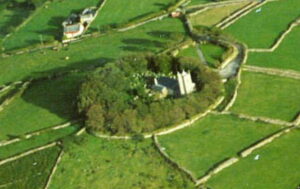Padstow has a well-established and enduring connection to Christianity and its early saints. The original settlement here at the entrance to the River Camel was founded by St Petroc and there is a holy well known as St George’s on the coastal path towards Stepper Point. So it seems natural that many believe that the name Dennis, which appears frequently around the town – Dennis Road, Dennis Hill, Dennis Farm, Dennis Cove – indicates that Padstow has some link to the 3rd century Christian saint, St Dennis, who was once Bishop of Paris.
Unfortunately this seems fairly unlikely. In fact, the truth is a little stranger and much more intriguing. Just like the inland village of St Dennis, about 25 miles from Padstow, the name has nothing to do with a saint and is actually connected to an ancient Cornish word – Dynas or Dinas which means castle, fort or prehistoric enclosure.
Variations of the word dennis
Variations of the word ‘dinas’ appear all over Cornwall from Dinas Head, Ruan Dynas and Tredyn Dinas to Castle an Dinas twice (which translates as Castle the Castle), indeed a small area of Padstow town is even known as Dinas. It is thought that Dennis is a corruption, an Anglicisation, of the Cornish. A quick glance at Dennis Hill’s seemingly excellent strategic position, a promontory overlooking the River Camel, and it is easy to imagine it as the site of an Iron Age Hillfort. Especially given that the Camel Valley area actually has a high density of ancient enclosures according to the Cornwall and Isles of Scilly Historic Environment Record.
Early Ordnance Survey maps also appear to mark some kind of circular feature on the hilltop before the Queen Victoria’s Jubilee Obelisk was erected there in 1887. So did an Iron Age hillfort once stand on Dennis Hill as many have long suspected? Sadly ancient history is never that straightforward. Local archaeologist Peter Herring explains that “Dynas was sometimes used to name features that looked like forts but weren’t, like geological formations on hilltops.” And that is what has been suggested here, the Historic England record for the site also confirms that there is a natural formation on the summit of the hill which looks like a prehistoric enclosure.
However, just to add a note of mystery, it is worth noting that the summit of Dennis Hill, as far as I have been able to establish, has not been thoroughly surveyed or excavated in any way in recent years, so . . . if you let your imagination run wild the possibilities are still very intriguing.

